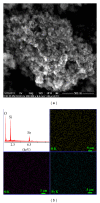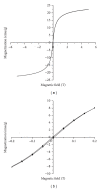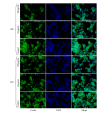Toxicity evaluation following intratracheal instillation of iron oxide in a silica matrix in rats
- PMID: 24949417
- PMCID: PMC4053145
- DOI: 10.1155/2014/134260
Toxicity evaluation following intratracheal instillation of iron oxide in a silica matrix in rats
Abstract
Iron oxide-silica nanoparticles (IOSi-NPs) were prepared from a mixture of ferrous chloride tetrahydrate and ferric chloride hexahydrate dropped into a silica xerogel composite. The structure and morphology of the synthesized maghemite nanoparticles into the silica xerogel were analysed by X-ray diffraction measurements, scanning electron microscopy equipped with an energy dispersive X-ray spectrometer, and transmission electron microscopy. The results of the EDAX analysis indicated that the embedded particles were iron oxide nanoparticles. The particle size of IOSi-NPs calculated from the XRD analysis was estimated at around 12.5 nm. The average size deduced from the particle size distribution is 13.7 ± 0.6 nm, which is in good agreement with XRD analysis. The biocompatibility of IOSi-NPs was assessed by cell viability and cytoskeleton analysis. Histopathology analysis was performed after 24 hours and 7 days, respectively, from the intratracheal instillation of a solution containing 0.5, 2.5, or 5 mg/kg IOSi-NPs. The pathological micrographs of lungs derived from rats collected after the intratracheal instillation with a solution containing 0.5 mg/kg and 2.5 mg/kg IOSi-NPs show that the lung has preserved the architecture of the control specimen with no significant differences. However, even at concentrations of 5 mg/kg, the effect of IOSi-NPS on the lungs was markedly reduced at 7 days posttreatment.
Figures












Similar articles
-
Amine modification of nonporous silica nanoparticles reduces inflammatory response following intratracheal instillation in murine lungs.Toxicol Lett. 2016 Jan 22;241:207-15. doi: 10.1016/j.toxlet.2015.11.006. Epub 2015 Nov 10. Toxicol Lett. 2016. PMID: 26562768 Free PMC article.
-
Effect of size and silica coating on structural, magnetic as well as cytotoxicity properties of copper ferrite nanoparticles.Mater Sci Eng C Mater Biol Appl. 2019 Apr;97:552-566. doi: 10.1016/j.msec.2018.12.051. Epub 2018 Dec 19. Mater Sci Eng C Mater Biol Appl. 2019. PMID: 30678942
-
Toxicity assessment of silica coated iron oxide nanoparticles and biocompatibility improvement by surface engineering.PLoS One. 2014 Jan 21;9(1):e85835. doi: 10.1371/journal.pone.0085835. eCollection 2014. PLoS One. 2014. PMID: 24465736 Free PMC article.
-
Influence of particle dose on the cytotoxicity of hamster and rat pulmonary alveolar macrophage in vitro.J Toxicol Environ Health. 1994 Aug;42(4):407-21. doi: 10.1080/15287399409531891. J Toxicol Environ Health. 1994. PMID: 8051715
-
Assessing toxicity of fine and nanoparticles: comparing in vitro measurements to in vivo pulmonary toxicity profiles.Toxicol Sci. 2007 May;97(1):163-80. doi: 10.1093/toxsci/kfm018. Epub 2007 Feb 14. Toxicol Sci. 2007. PMID: 17301066
Cited by
-
TiO2 Nanoparticles Caused DNA Damage in Lung and Extra-Pulmonary Organs Through ROS-Activated FOXO3a Signaling Pathway After Intratracheal Administration in Rats.Int J Nanomedicine. 2020 Aug 21;15:6279-6294. doi: 10.2147/IJN.S254969. eCollection 2020. Int J Nanomedicine. 2020. PMID: 32904047 Free PMC article.
-
Inhaled Cadmium Oxide Nanoparticles: Their in Vivo Fate and Effect on Target Organs.Int J Mol Sci. 2016 Jun 3;17(6):874. doi: 10.3390/ijms17060874. Int J Mol Sci. 2016. PMID: 27271611 Free PMC article.
-
New Insights into the Biological Response Triggered by Dextran-Coated Maghemite Nanoparticles in Pancreatic Cancer Cells and Their Potential for Theranostic Applications.Int J Mol Sci. 2023 Feb 7;24(4):3307. doi: 10.3390/ijms24043307. Int J Mol Sci. 2023. PMID: 36834718 Free PMC article.
-
Basic study of intratracheal instillation study of nanomaterials for the estimation of the hazards of nanomaterials.Ind Health. 2018 Feb 7;56(1):30-39. doi: 10.2486/indhealth.2017-0082. Epub 2017 Sep 5. Ind Health. 2018. PMID: 28883208 Free PMC article.
-
Lung and general health effects of Toll-like receptor-4 (TLR4)-interacting SPA4 peptide.BMC Pulm Med. 2020 Jun 23;20(1):179. doi: 10.1186/s12890-020-01187-7. BMC Pulm Med. 2020. PMID: 32576172 Free PMC article.
References
-
- Baratli Y, Charles AL, Wolff V, et al. Impact of iron oxide nanoparticles on brain, heart, lung, liver and kidneys mitochondrial respiratory chain complexes activities and coupling. Toxicology in Vitro. 2013;27(8):2142–2148. - PubMed
-
- Ferreira AJ, Cemlyn-Jones J, Robalo Cordeiro C. Nanoparticles, nanotechnology and pulmonary nanotoxicology. Revista Portuguesa de Pneumologia. 2012;19(1):28–37. - PubMed
-
- Mahmoudi M, Sant S, Wang B, Laurent S, Sen T. Superparamagnetic iron oxide nanoparticles (SPIONs): development, surface modification and applications in chemotherapy. Advanced Drug Delivery Reviews. 2011;63(1-2):24–46. - PubMed
-
- Tari A, Chantrell RW, Charles SW, Popplewell J. The magnetic properties and stability of a ferrofluid containing Fe3O4 particles. Physica B&C. 1979;97(1):57–64.
-
- Poizot P, Laruelle S, Grugeon S, Dupont L, Tarascon J-M. Nano-sized transition-metal oxides as negative-electrode materials for lithium-ion batteries. Nature. 2000;407(6803):496–499. - PubMed
Publication types
MeSH terms
Substances
LinkOut - more resources
Full Text Sources
Other Literature Sources

